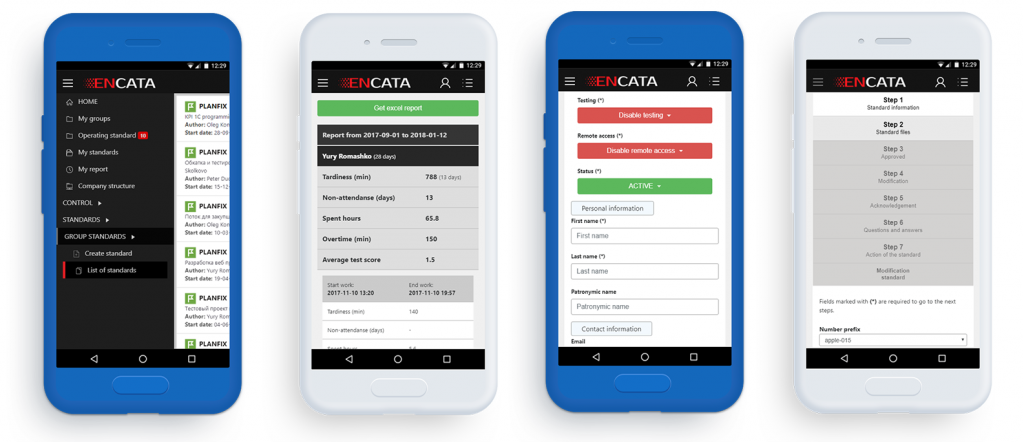Business Process Automation Software Development for EnCata
A web application for internal management of employees, business processes, and corporate resources.

Challenge
Our client — EnCata (Engineering Catalyst) — is a one-stop provider of prototyping, engineering, and consultancy services for manufacturers worldwide.
Before EnCata became our client, we reached out to them first, to prototype the hardware that Mbicycle’s CEO Igor Nikolaev required for his healthcare startup, Smart Pourer. For the startup’s purposes, they needed to invent a unique device — a smart pourer to control alcohol consumption. Choosing from a number of engineering companies, Igor and his partners contacted EnCata because they were able to offer the most appropriate hardware solution to meet the startup’s requirements.
During this cooperation, EnCata’s executives learned much about Mbicycle’s custom software development services and expertise in web app development. So when EnCata themselves needed a leg-up with developing their new software for internal management, they didn’t hesitate to hire Mbicycle’s experts for this task.

The Solution: Business Process Automation App
The project background
EnCata had its own specific structure with narrow-focused departments. To organize operational processes, accounting, supply, and others, our client used two software products — 1C and Planfix.
While Planfix was used by senior managers to assign tasks to the employees by department, the 1C software was used for:
- Managing the enterprise structure
- Implementing workflow standards for the departments
- Conducting comprehensive and partial assessment of employees to check the relevance of their knowledge
- Managing departmental work schedules
- Appointing managers
- Creating various types of reports
- Recording clock-in and clock-out time
- Training employees in various fields, etc.
The client had run into two main issues with the tools they used:
- 1C is a comprehensive system covering multiple workflows. Even though our client needed only a few of its features, they had to support the entire system, which was very resource-consuming.
- Because 1C and Planfix are isolated systems, there was a bottleneck in integrating them with each other for better interoperability and visibility into corporate processes.
Our solution
Based on the client’s existing technology stack and project requirements, Mbicycle’s experts decided to develop a web application close to the 1C software functionality but also with the Planfix features integrated. That would allow users to see all their notifications from 1C and Planfix in one place. Thus, the main idea was to simplify the daily routine tasks of EnCata’s employees by providing them with a simple, lightweight, and intuitive operating tool.
When we took up the project, EnCata had about 200 employees. Since the client was planning for the future growth, our goal was to achieve:
- High fail-safety
- 24/7 availability of the app
- Security and privacy of user data
- High app performance
- Fool-proof security of the entire system, to mitigate potential human errors, for example, invalid data sent
To satisfy all these requirements, we developed a turnkey business process automation solution with two interconnected parts:
- The distributed server application that could easily scale in the future without causing any changes to the source code of the app logic.
- The frontend as an interactive part of the system.
The solution developed by our team offered the following feature set:
- Management of enterprise standards, which are sets of instructions and rules for employees to follow.
- Employees’ knowledge assessment.
- Reporting by departments, with the reports further used by the company’s executives to decide on employees’ recognition.
- Adding or changing employees’ accounts, departments, etc.
- Viewing employees’ individual tasks integrated from 1C and Planfix.
- IP login restrictions overseen by administrators.
- Notifications of changes in the enterprise standards (via email and within the app).
- Upskilling tools for employees.
- Proposal lists submitted by employees.
Process
The entire web app development team was on the Mbicycle side and included backend and frontend developers, a business analyst, a project manager, a team lead, and a designer.
Before the development started, we created a list of the client’s requirements and conducted a preliminary business analysis. Based on its results, the entire scope of tasks was divided into several iterations. After each iteration, we arranged demo sessions for the client. During these sessions, we showed new functionality in real-time while discussing upcoming tasks and improvements with EnCata’s team.
The software development stage began with setting up the infrastructure for several loops — development, testing, and product ones. The frontend and backend development processes were all carried out simultaneously but timed so that the backend services were created a week ahead in order to provide API services for the frontend.
After several iterations within the development and testing loops, the Mbicycle team released the first MVC version and transferred the application to the product loop, providing access to real end-users. During further iterations, our team carried out project improvements and adjustments, which were checked by the client and then deployed to their servers.

Technologies & Tools
Programming language
Java
Architecture
MVC
Frontend
Angular
Third-party libraries & frameworks
Spring, Spring Cloud, MongoDB, Redis, AWS, Docker, Planfix, Amazon SES, Amazon S3
Results
We took up the EnCata project and provided the MVC product version three months later. Our team has improved the client’s system according to the predefined workflow and requirements. Then we were granting access gradually to EnCata’s management departments so that they could add all the necessary information about their internal standards.
After eight months of development, the application was introduced to the end-users. Also, for a few months since the release, experts from Mbicycle outsourcing development company have been enhancing the app functionality based on user reviews.
As a result of this collaboration between EnCata and Mbicycle, our experts have successfully implemented all the required functionality and fully delivered business process automation services to the client. The EnCata team was very satisfied with the results and is now actively using the system for their day-to-day business process management.




